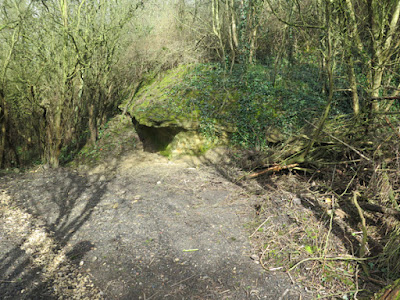 |
| A view down Markland Grips |
Having had a good 2 km walk from Clowne town centre, along the Linear Park, during which we had a good look at the uppermost beds of the Wetherby Member - the lower part of the Cadeby Formation – our guide Jim then took us up a steep undefined path that took us up to the road bridge that led us down to the confluence of the watercourses that run through Hollinhill Grips and Markland Grips.
 |
| The water course flowing from Markland Grips |
Both Paul May and I were satisfied that this rough path could be managed by all of the Sheffield U3A Geology Group members and we continued along the path past Upper Field Farm, where a rock face of thinly bedded dolomitic limestone from the Cadeby Formation is stained red.
 |
| Red stained limestone |
I have seen a few places where similar staining occurs, including the nearby Creswell Crags and Lindrick Dale quarry further to the north, and I have often wondered if they are derived from beds of ochre in the limestone called ruddle, which once formed the raw material for a small industry in the village of Braithwell on the Rotherham/Doncaster boundary.
According to the geological memoir, the strata exposed at the surface around Hollinhill Grips and Markland Grips are the upper subdivision of he Cadeby Formation – the Sprotbrough Formation – a wedge bedded example of which I had seen just before we left the Linear Park.
 |
| An extract from the Ordnance Survey map |
On a geological map, the position of Markland Grips, which splits into two upstream, and Hollinhill Grips are clearly demarcated by the presence of head, composed of blocks of rock and soil that formed by the process of solifluction during the Quaternary Period, and an Ordnance Survey map shows plenty of rock outcrops alongside either side of these.
 |
| A general view of the crags |
Walking along the path to the east side of Markland Grips, many rock faces are obscured by ivy and other vegetation and views to the other side are obscured by trees. Furthermore, much of the valley floor is occupied by wet and boggy ground that prevents easy exploration of its west side.
 |
A view across boggy ground
|
There are several places where the limestone can be examined close up, however, and in places joints have been widened to the extent that they have been used as rock shelters during the Neolithic period.
 |
A rock shelter
|
Although very little can been from the valley, added archaeological interest to the field trip is provided by an Iron Age promontory fort, which was strategically placed at the confluence of the principal watercourse, but we again couldn’t see much because of the trees.
 |
| Wedge bedded limestone |
Continuing towards Markland Grips Viaduct, another outcrop of limestone displays further examples of wedge bedding, which are considered to be characteristic of the Sprotbrough Member, and there is a large isolated block of limestone.
 |
A large isolated block of limestone
|
At this point, our guide Jim took us up onto the old railway that leads back to the Linear Park and Clowne town centre, where we finished our walk and thanked him for his input – especially since he had offered to accompany us on our planned field trip a few days later.  |
| Crags on the west side of Markland Grips |

















































